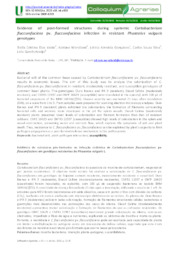Evidence of post-formed structures during systemic Curtobacterium flaccumfaciens pv. flaccumfaciens infection in resistant Phaseolus vulgaris genotypes.
Evidence of post-formed structures during systemic Curtobacterium flaccumfaciens pv. flaccumfaciens infection in resistant Phaseolus vulgaris genotypes.
Autoria: VALDO, S. C. D.; WENDLAND, A.; GONÇALVES, L. A.; SILVA, C. S.; ARAÚJO, L. G.
Resumo: Bacterial wilt of the common bean caused by Curtobacterium flaccumfacienspv. flaccumfaciensresults in economic losses. The aim of this study was to analyze the colonization of C. flaccumfaciens pv. flaccumfaciens in resistant, moderately resistant, and susceptible genotypes of common bean plants. The genotypes OuroBranco and IPA 9 (resistant), Diacol Calima (moderately resistant), and CNFRS 11997 and CNFP 10429 (susceptible) were inoculated in the epicotyl, with 100 ?L of bacterial suspension of the BRM 14933(Cff25). Disease severity was evaluated 21 days after inoculation (DAI), on a scale from 1 to 9. Plant samples were prepared for scanning electron microscopy analyses. Ouro Branco and IPA 9 (resistant) plants exhibited low colonization, the formation of filaments surrounding bacterial cells and vestures more developed in the pit the xylem vessels. Diacol Calima (moderately resistant) plants presented lower levels of colonization and filament formation than that of resistant cultivars. CNFC 10429 and CNFRS 11997 (susceptible) showed high levels of colonization in the xylem and vessel obstruction, preventing water and nutrient flow, which explains the symptoms of wilt and plant death. Thus, resistance to C. flaccumfacienspv. flaccumfacienscan be explained by plant’s capacity to limit pathogen propagation as a post-formed defense mechanismin this pathosystem
Ano de publicação: 2022
Tipo de publicação: Artigo de periódico
Unidade: Embrapa Arroz e Feijão
Observações
1 - Por padrão são exibidas publicações dos últimos 20 anos. Para encontrar publicações mais antigas, configure o filtro ano de publicação, colocando o ano a partir do qual você deseja encontrar publicações. O filtro está na coluna da esquerda na busca acima.
2 - Para ler algumas publicações da Embrapa (apenas as que estão em formato ePub), é necessário ter, no celular ou computador, um desses softwares gratuitos. Sistemas Android: Google Play Livros; IOS: iBooks; Windows e Linux: software Calibre.
Acesse outras publicações
Acesse a Base de Dados da Pesquisa Agropecuária (BDPA) para consultar o acervo completo das bibliotecas da Embrapa.

